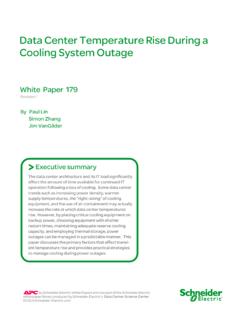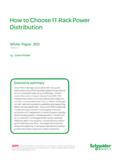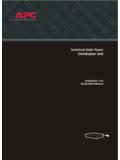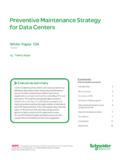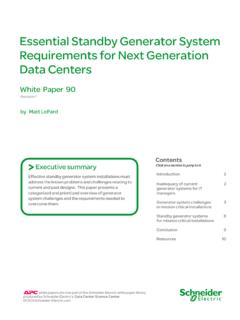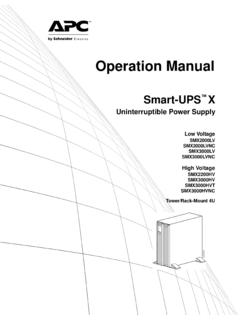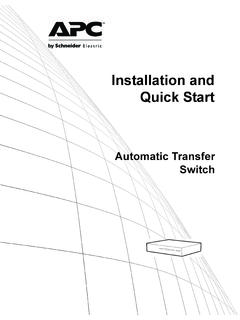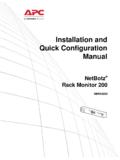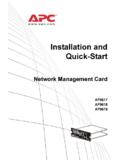Transcription of A Quantitative Comparison of High Efficiency AC vs. DC ...
1 A Quantitative Comparison of high Efficiency AC vs. DC power distribution for data Centers White Paper 127. Revision 4. by Neil Rasmussen and James Spitaels > Executive summary This paper presents a detailed Quantitative Efficiency Comparison between the most efficient DC and AC. power distribution methods, including an analysis of the effects of power distribution Efficiency on the cooling power requirement and on total electrical consumption. The latest high Efficiency AC and DC. power distribution architectures are shown to have virtually the same Efficiency , suggesting that a move to a DC-based architecture is unwarranted on the basis of Efficiency . by Schneider Electric White Papers are now part of the Schneider Electric white paper library produced by Schneider Electric's data center Science center A Quantitative Comparison of high Efficiency AC vs.
2 DC power distribution for data Centers Introduction The quest for improved Efficiency of data centers has encouraged a climate of innovation in data center power and cooling technologies. One widely discussed energy Efficiency proposal is the conversion of the data center power architecture to DC from the existing AC. Numerous articles in the popular press and technical magazines have made claims for the advantages of DC power distribution , and companies such as Intel, Schneider Electric, and Sun Microsystems have participated in technology demonstration projects. There are five methods of power distribution that can be realistically used in data centers, including two basic types of alternating current (AC) power distribution and three basic types of direct current (DC) power distribution . These five types are explained and analyzed in the related White Paper 63, AC vs.
3 DC power distribution for data Centers. A key finding in that paper, which is generally supported in the published literature, is that two of the five distribu- tion methods, one AC and one DC, offer superior electrical Efficiency . This paper focuses on comparing only those two highest Efficiency distribution methods. Unless there is a major change in data center power technology, one of these two methods is very likely to become the preferred method for distributing power in future data centers down to the pod or rack level. It is possible that both methods would exist within the pod or rack level. The Efficiency performance values for the AC power distribution system described in this paper are readily available numbers based on actual equipment that can be purchased today. Commercial 380V DC power distribution systems are not widely available today, so the Efficiency values for the DC power distribution system are based on preliminary manufactur- ers' data , estimates, and calculations available.
4 Citations and references are provided for all Efficiency values used in this paper, so that the findings can be independently tested and verified. Changes in power distribution Efficiency affect the total electrical power consumption of the data center . However, the impact is mathematically complex because of two factors: 1. Variations in electrical power distribution Efficiency affect the heating load and conse- quently the air conditioning power consumption. 2. There are significant power loads in the data center that do not receive power through the power distribution system under study. This paper explains these effects in detail and shows how improvements in electrical power distribution Efficiency quantitatively translate into reductions in total electrical consumption. Background It is true today that there are existing data center installations with poor designs and older power distribution technology that are operating at very low efficiencies.
5 Schneider Electric has observed power system efficiencies of 30% and even less in operating data centers (exclusive of the cooling system). This represents a tremendous waste of electrical energy since much of this inefficiency is avoidable. The observed inefficiencies are primarily due to the following factors: Inefficient IT device power supplies Inefficient transformer-based power distribution units (PDUs). Inefficient UPS systems Operation at loads well below the design rating of the system, which amplifies all of the above losses Schneider Electric data center Science center Rev 4 2. A Quantitative Comparison of high Efficiency AC vs. DC power distribution for data Centers There have been great improvements in Efficiency of IT device power supplies and UPS. systems since 2007. This means that an AC distribution system installed today is typically much more efficient than installations prior to 2007.
6 In addition, modular scalable UPS. systems have made it simpler to right-size a UPS to the load, preventing the electrical inefficiency due to gross underutilization frequently seen in the past. Transformer-based PDUs remain a significant source of loss in many North American installations, but are not prevalent outside of North America. The AC system analyzed in this paper is based on the European standard of 400/230 V distribution . The application of 400/230 V AC power distribution in North America is discussed in detail in White Paper 128, Increasing data center Efficiency by Using Improved high Density power distribution . DC distribution has been proposed as a way to achieve higher Efficiency based on the following three premises: 1. It may be possible to build a DC UPS that is higher in Efficiency than an AC UPS. 2. The elimination of power distribution unit (PDU) transformers will reduce electrical losses 3.
7 It may be possible to improve the Efficiency of the IT equipment power supply itself, beyond the improvements possible in an AC input design This paper examines and quantifies all of these concepts and reveals the following: The latest generation of AC UPS systems has as much as five times less loss than previous generations of AC UPSs, and there is no longer any evidence that a DC UPS. of greater Efficiency can be created Transformers in PDUs are a significant source of inefficiency, but don't exist outside of North America and are eliminated in new high Efficiency AC power distribution architec- tures The Efficiency improvements in the IT equipment power supply resulting from conver- sion to DC input are proving to be much lower in practice than was originally assumed In many published articles, expected improvements of 10% to 30% in Efficiency have been claimed for DC over AC.
8 But, as you would not compare the performance of a new server technology to the performance of a server made ten years ago, it is similarly inappropriate to compare hypothetical DC power distribution Efficiency to the Efficiency of older legacy AC. power distribution systems. The important Comparison is not between past and future alternatives, but between current and future alternatives. The data in this paper demonstrates that the best AC power distribution systems today already achieve essentially the same Efficiency as DC systems, and that most of the quoted Efficiency gains in the popular press are misleading, inaccurate, or false. And unlike virtually all other articles and papers on this subject, this paper includes citations and references for all of the Quantitative data . The two high The introduction explained that two alternative power distribution systems have emerged as candidates for building future high Efficiency data centers.
9 One system is based on the Efficiency existing predominant 400/230 V AC distribution system currently used in virtually all data power centers outside of North America and Japan. The other system is based on a conceptual 380. distribution V DC distribution system supplying IT equipment that has been modified to accept DC power . These systems are diagrammed in Figure 1 and Figure 2. options Schneider Electric data center Science center Rev 4 3. A Quantitative Comparison of high Efficiency AC vs. DC power distribution for data Centers Figure 1. high Efficiency AC. distribution (in common use AC 400/230 V AC IT. outside North America) UPS LOADS. Figure 1 represents the first candidate. It is the common AC distribution system used outside of North America and Japan. Note that in today's standard North American power distribution system, the UPS voltage would be 480 V AC and there would be an additional block in the diagram representing a PDU transformer to convert 480 V to 208/120 V AC.
10 In this figure the PDU transformer and the associated losses are eliminated because there is no need to step down the UPS output voltage before supplying it to IT loads at 230 V. Figure 2. DC 380 V DC IT. high Efficiency DC. distribution (hypothetical) UPS LOADS. Figure 2 represents the second candidate use to distribute 380 V DC. IT devices designed to operate from 380 V DC power are required to allow this to work. This system has been proposed in the literature with a variety of different DC supply voltages, such as 300, 380, 400, and 575 V. However, a consensus in the literature has developed around 380 V as a preferred standard, and the analysis in this paper is based on this 380 V DC system. In the proposed international ETSI standard 1 for DC distribution for data centers, the 380V DC. system is actually created with the midpoint at ground potential to keep the maximum system voltage to ground to within +/- 190 V.
